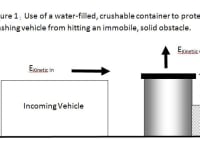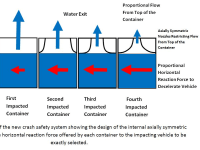A highly successful innovation to increase highway safety was the introduction of water-filled crash barriers at various high-danger locations. Many of these barriers are cylindrical is shape with a detachable cover. They are made of an easily crushable/deformable material and are filled with ordinary water. The theory of operation of these barriers is simple: The incoming vehicle comes in forceful contact with the barrier and begins to crush it. The rapid deformation of the container causes the horizontal kinetic energy of the vehicle to be transferred to the vertical kinetic energy of the water as it is projected upwards from the container, thereby slowing the vehicle. Several crushable barriers are positioned in front of each other to make sure that the vehicle comes to a complete stop before hitting the obstacle. A schematic is shown in Figure 1.
The purpose of the proposed innovation is to provide a gradually increasing resistance force to the vehicle as it crashes into the water filled containers. Existing barriers all provide an equivalent decelerating force to the vehicle, which may not be sufficient to completely stop the vehicle before the solid obstacle is encountered. As a result, on high speed roads, 5 or more containers must be mounted in front of each barrier in order to be certain of stopping an impacting vehicle. This adds significantly to costs.
Experimental work has shown that the provision of a "nozzle" at the top of the water container can constrain the rate of water discharge from the top of the container and increase the magnitude of the decelerating force applied to the vehicle. The new system for decelerating the vehicle will consist of a series of deformable containers, with each subsequent container having a nozzle with a smaller diameter than the previous one in the series. A cross-sectional view of the design of this vehicle protection system is shown in Figure 2:
The advantages of the new safety system include:
•Fewer crash containers have to be used for a given average road speed, dramatically reducing overall costs
•Greater safety, as there is more confidence that a vehicle will be brought to a complete stop before impacting the solid obstacle
•The system can be designed to stop much heavier vehicles such as transport trucks
•No dramatic change in manufacturing is required. The existing design only has to be slightly modified and the modifications do not add any significant additional costs to the system
Like this entry?
-
About the Entrant
- Name:Paul Tinari
- Type of entry:individual
- Hardware used for this entry:DELL Work StationSoftware used for this entry:AutoCAD
- Patent status:none





